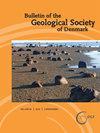Development of the western Limfjord, Denmark, after the last deglaciation: a review with new data
IF 1
4区 地球科学
Q2 Earth and Planetary Sciences
引用次数: 12
Abstract
This paper presents new marine evidence of Lateglacial and Holocene environmental changes in the western part of Limfjorden, and provides a review of the geological history/development of this part of northern Jylland, Denmark. Lateglacial clay without fossils is widespread in the region and is probably a glaciolacustrine deposit. Limfjorden began to form as a strait in the Early Holocene due to rising relative sea level and the oldest marine shells are dated to c. 9300 cal. years BP. We propose a new relative sealevel curve for the region based on new and published data, which appear to confirm that the relative sea-level change was not extremely rapid, which was suggested earlier. During the Mid-Holocene a wide connection existed from the western part of Limfjorden to the North Sea in the west and more narrow connections existed between Limfjorden and Skagerrak in the north. The marine fauna included several species that indicate warmer and more salty waters than at present. Gradually, the connections to the North Sea and Skagerrak closed due to long-shore sediment transport and deposition of aeolian sand combined with a fall in the relative sea level during the Middle- to Late Holocene. During the Viking Age, 800–1050 CE (Common Era), the western connection to the North Sea was still open, but around 1200 CE it was closed by a coastal sandy barrier and the western part of Limfjorden became brackish. The coastal barrier was flooded on several occasions but soon formed again. After 1825 CE the western connection from Limfjorden to the North Sea has been maintained artificially.最后一次冰期后丹麦利姆峡湾西部的发展:新资料综述
本文提供了林峡湾西部晚冰期和全新世环境变化的新海洋证据,并对丹麦Jylland北部这一地区的地质历史/发展进行了回顾。没有化石的晚冰质粘土在该地区广泛分布,很可能是冰川沉积物。由于相对海平面上升,Limfjorden在全新世早期开始形成海峡,最古老的贝壳可追溯到公元前9300年。我们根据新公布的数据为该地区提出了一条新的相对海平面曲线,这似乎证实了相对海平面的变化并不像早些时候提出的那样迅速。全新世中期,林峡湾西部与西部北海之间存在着广泛的连接,而林峡湾与北部斯卡格拉克之间存在着更为狭窄的连接。海洋动物群包括几个物种,表明海水比目前更温暖、更咸。在全新世中期至晚期,由于长海岸沉积物的输送和风积沙的沉积,以及相对海平面的下降,与北海和斯卡格拉克的连接逐渐关闭。在公元前800–1050年的维京时代(共同时代),与北海的西部连接仍然开放,但在公元前1200年左右,它被海岸沙屏障封闭,林峡湾的西部变得微咸。海岸屏障曾多次被洪水淹没,但很快又形成了。公元1825年以后,从林峡湾到北海的西部连接一直由人工维持。
本文章由计算机程序翻译,如有差异,请以英文原文为准。
求助全文
约1分钟内获得全文
求助全文
来源期刊

Bulletin of the Geological Society of Denmark
GEOSCIENCES, MULTIDISCIPLINARY-
CiteScore
2.80
自引率
16.70%
发文量
28
审稿时长
>12 weeks
期刊介绍:
The Bulletin publishes contributions of international interest in all fields of geological sciences on results of new work on material from Denmark, the Faroes and Greenland. Contributions based on other material may also be submitted to the Bulletin if the subject is of relevance for the geology of the area of primary interest.
 求助内容:
求助内容: 应助结果提醒方式:
应助结果提醒方式:


